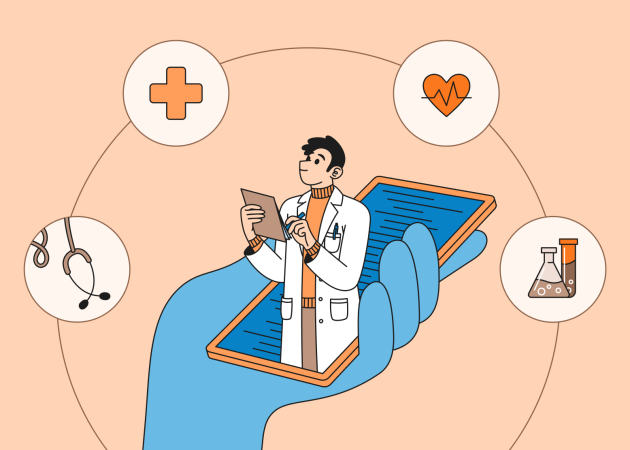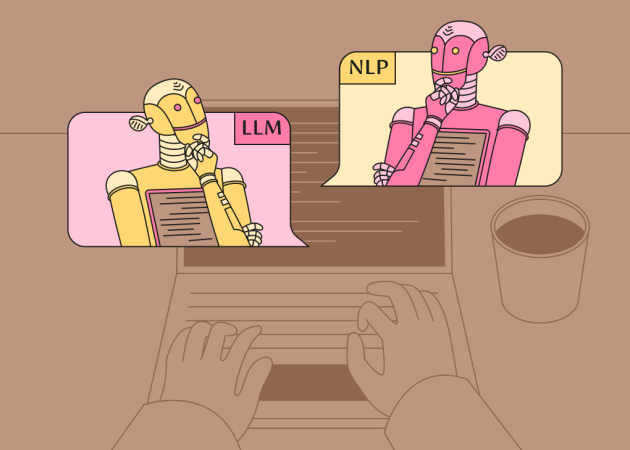
Top Telemedicine Trends Shaping the Future of Digital Health
Contents
Contents
Propelled by the pandemic, telehealth and telemedicine are among the fastest-growing industries in the world, with the global market size estimated to more than double in revenues from $120.4 billion in 2023 to $285.7 by 2028. Healthcare organizations are now reevaluating the future of telehealth and working to develop a more intentional and sustainable approach to virtual care.
Hospitals and health systems that were uncertain about telehealth services before the pandemic have now firmly decided to adopt them strategically. Telemedicine has become too important to overlook, especially in light of the ongoing healthcare workforce shortages, efforts to control labor costs, provider burnout, and the need to expand access to care for broader populations. Now, let’s discuss the current trends that are having the most impact in the industry.
Trend #1: Artificial intelligence
The skyrocketing progress of AI in software development has increased its value for healthcare and telemedicine. AI-powered systems improve diagnostic accuracy, automate patient communication, help generate medical insights, support clinical decision-making, and enhance the operational efficiency of medical services. A general rule of thumb for all AI use cases in healthcare is that they should be treated ethically, responsibly, and with caution toward the privacy and safety of sensitive patient data.
AI chatbots and virtual assistants
Serving as the first point of contact for consumers in the healthcare system, chatbots can answer FAQs, provide basic medical advice, direct users to relevant resources, schedule appointments, send reminders and follow-ups, and more. Moreover, AI-assisted triage systems help address the workforce shortages in clinical teams. By analyzing patient data and symptoms, they can conduct initial assessments and direct patients to the most appropriate care level. This helps unload primary care teams and free up resources for more complex cases so they can focus on delivering timely treatment.
As GenAI progresses, an increasing number of healthcare organizations are interested in integrating LLM-based chatbots into their operations. Medical-specific models like Google’s Med-PaLM are on the rise. AI chatbots already perform on par or even better than human clinicians in answering patient questions. In one experiment, ChatGPT scored higher than human doctors in terms of quality (4 vs. 3.33) and empathy (4.67 vs. 2.33). In another case, ChatGPT produced clinical notes that were hard to distinguish from those written by doctors, even for professional reviewers.

AI-assisted medical imaging
The application of deep learning algorithms to CT and MRI scans helps clinicians detect abnormalities that may be otherwise hard to see for the human eye, leading to more accurate and effective diagnostics. AI algorithms can identify complex patterns in imaging data, provide quantitative evaluations of radiographic traits, distinguish signals from noise, and detect image modalities, such as tumor delineation at different treatment stages. AI-powered imaging is already being used to treat cardiovascular and neurological conditions, for cancer screening and tumor classification, and to detect hard-to-diagnose fractures or dislocations. With the advances in computer vision and improvements in both the accuracy and reliability of generative AI, it can be used for a growing number of imaging analysis tasks.
Clinical data management
As telemedicine advances, the role of AI grows in handling massive volumes of healthcare data. Studies revealed that it is possible to eliminate about four months (3,000 hours) of manual review in a single AI trial, freeing up valuable time for medical teams. With AI algorithms that automate data entry and other routine tasks, they can move forward with structuring and migrating information from one EHR (Electronic Health Record) to another. The integration of patient data into the EHR system using AI creates a comprehensive view of a patient’s health history, helping generate medical insights for more accurate diagnostics and treatment while minimizing human error.

Trend #2 Remote patient monitoring and chronic care management
Currently, 34% of healthcare organizations in the United States provide remote patient monitoring. This allows them to track patients’ vital signs, symptoms, and activity levels to assess their health, detect any issues early, and adjust treatment. With the aging population and increasing number of patients with disabilities and chronic conditions, RPM is expected to grow in popularity. This trend is also driven by hospital-at-home technology that creates a smart, real-time world for patients who need hospital care but are stable enough to be home. The use of RPM within HaH could match the standard clinical practice of regular vital checks, enabling safe and consistent care.
One of Beetroot’s in-house R&D projects, Eshmun, is a telehealth app designed to assist trained nurses or family members in monitoring the health status of elderly patients using real-time telemetry. On the one hand, telemedicine enables us to convert Beetroot’s cross-team expertise into cutting-edge HealthTech projects. On the other hand, the tangible difference it creates for patients and care providers inspires us to hone our experience and solve specific challenges. As one of our colleagues said:
“The most exciting thing for me in this project is collecting data from devices and using it to simplify caregivers’ routine tasks. Some healthcare-specific challenges, like privacy and data security, appeal to me too. Realizing that people’s lives can literally depend on your product’s reliability gives extra motivation to work harder.”
— Vitalii Huliai, Tech Team Lead, Beetroot
Trend #3 Telehealth-enabled wearable devices
The popularity of smartwatches, fitness trackers, and other wearables aligns perfectly with the previous trend. Imagine your Apple Watch seamlessly integrating with your telemedicine platform, providing doctors with a holistic view of your health beyond traditional consultations. Real-time data integration, combined with gamification and personalized feedback, can incentivize healthy behaviors and lead to improved patient engagement and self-care.
Advanced wearable sensors can detect physiological and biochemical markers critical for early disease diagnosis and monitoring chronic conditions. Some emerging medical wearables like ADAMM by Health Care Originals or SEERS Bio Patch can monitor respiration, heart rate, and temperature. Others detect seizures (Embrace 2 by Empatica), patient position and steps to prevent pressure ulcers (Leaf Sensor by Leaf Healthcare Inc.), or even track women’s fertility (Ava by Ava Science Inc.).
Trend #4 Mobile health apps
The ‘mobile health’ category is arguably the broadest term in telemedicine. At the end of 2023, there were over 350,000 apps available for both consumers and healthcare professionals. These apps allow users to take a proactive role in their health, from diet adherence, fitness, and mindfulness to tracking vital health data that synchronizes with their medical records. No wonder mHealth apps are one of the most invested digital health segments in the world.

Digital health accessibility
Digital health solutions aim to reduce health disparities through patient-oriented telemedicine apps, with the ultimate goal of achieving greater equity. At the same time, the focus on only cutting-edge technologies is a double-edged sword. There are many blockers and challenges to wide access to digital healthcare for low-income, less educated, and older populations, who may lack the digital skills and capable physical devices to use the technology. Additionally, digital tools should be easily accessible and understandable for everyone, including people with disabilities.
In particular, people with hearing and speech impairments face significant barriers during medical consultations and have limited access to health information. Inspired by our collaboration with a team member with hearing and speech challenges, Beetroot designed Speak’n’Hear, an app for deaf, hard-of-hearing, and speech-disabled users. It’s a testament to how personal experiences within our team can lead to meaningful innovation.
Quoting Rana Ersgård, Beetroot’s co-CEO, “Both Speak’n’Hear and Eshmun exemplify our commitment to technology driven by empathy and real-life experiences, leading to solutions that resonate on a human level and can also achieve commercial success.”
Digital accessibility is driven by legal regulations, such as the ADA and Section 508, and formal guidelines, such as WCAG, which aim to expand accessibility even further.

Trend #5 IoT and IoMT
The Internet of Things (IoT) and collecting health data with external devices aren’t new. However, a growing trend in telehealth involves connecting more devices, such as glucose monitors, nutrition trackers, and mobility sensors, to improve health outcomes. Medical IoT connects physical objects with sensors and software that communicate with other digital devices, allowing healthcare professionals to make better decisions with accurate, up-to-date data. And with the advancements in AI, these devices will only become smarter and more capable.
The ability to sync with mobile apps makes this digital health technology even more impactful. With over 300 million smart homes estimated globally, the integration of telehealth services with smart home appliances signals a new direction toward holistic healthcare. Besides tracking health vitals, these integrated systems will help monitor various aspects of a consumer’s living environment, such as the quality of air, water, ambient temperature, sleep patterns, lifestyle, and so on. All of that expands telehealth to include more factors that may impact health, opening more doors to innovation.
Stay ahead of telemedicine trends with Beetroot
As a global healthcare trend, telemedicine and telehealth are propelled by the growing preference for online consultations, tremendous growth, and adoption in hybrid and virtual primary care, asynchronous medicine, chronic care management, and on-demand care models. As digital solutions, they are driven by technological advancements, convenience, and tangible benefits for patients and health systems.
As a tech ecosystem, Beetroot is inspired and committed to applying our expertise to create solutions rooted in real-world problems that make a difference in people’s lives. Partnering with us means joining forces with a dedicated team motivated to drive sustainable development in healthcare. Contact us today to discover how we can help you transform your healthcare delivery and make a lasting impact.
Subscribe to blog updates
Get the best new articles in your inbox. Get the lastest content first.
Recent articles from our magazine
Contact Us
Find out how we can help extend your tech team for sustainable growth.







